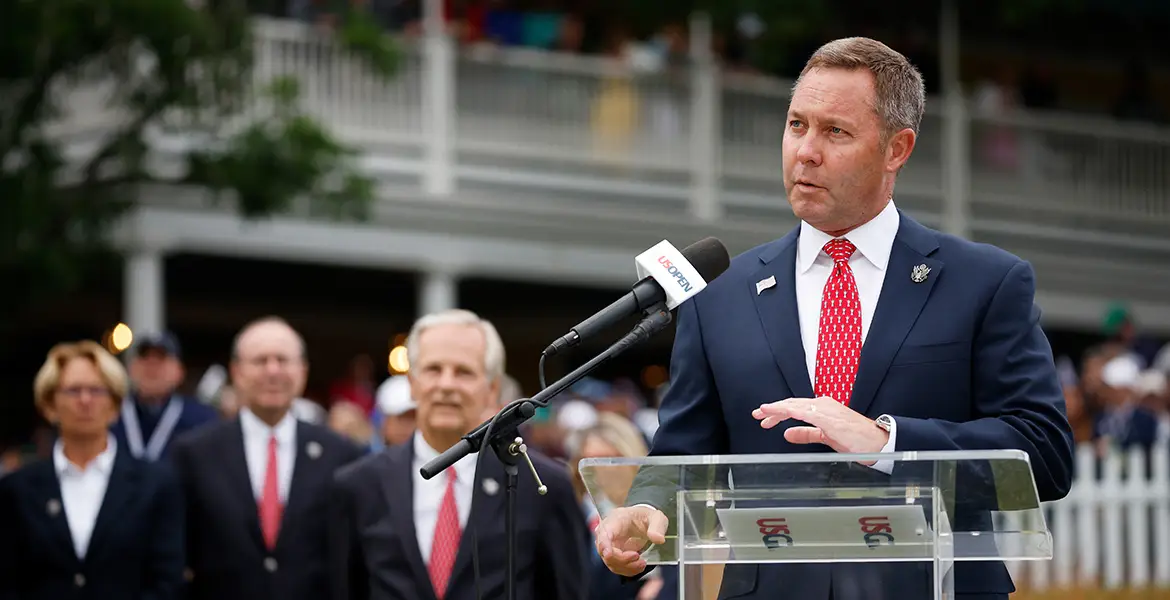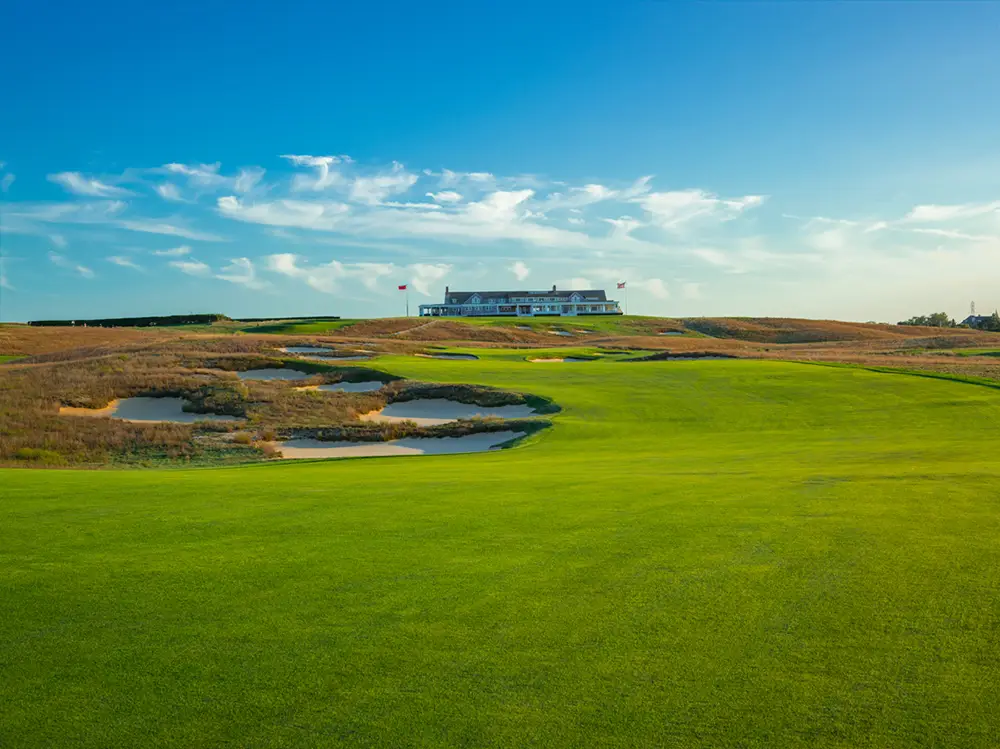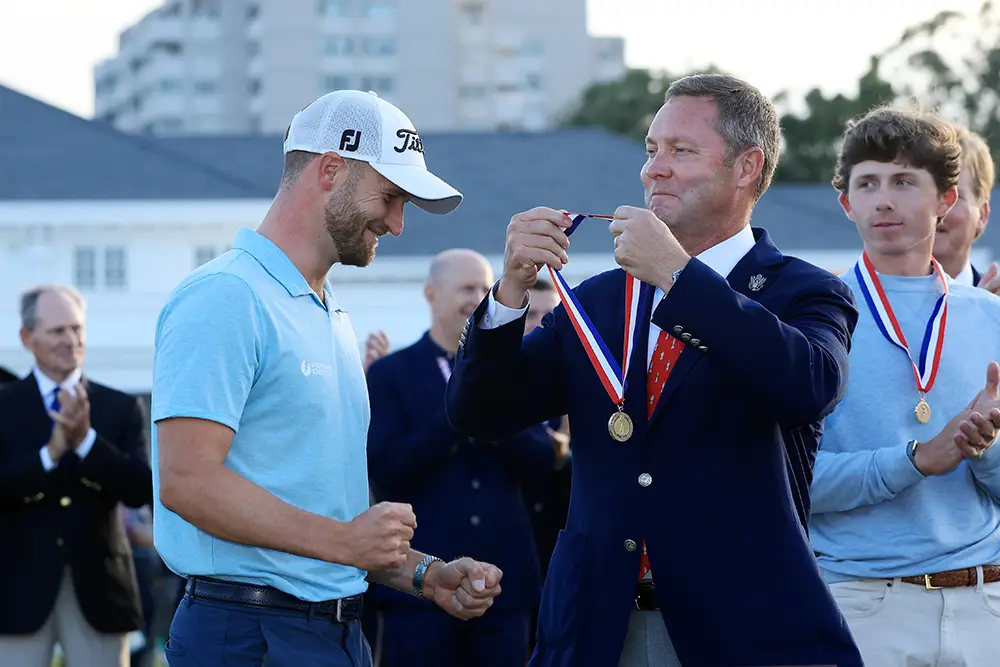After a 12-year run as Commissioner of the LPGA, Mike Whan took the helm of the USGA on July 1, 2021. While professional golf may be at a crossroads due to the PGA Tour/LIV divide, Whan is bullish on the game of golf itself, which is currently flourishing under the auspices of his organization.
With the U.S. Open mere days away at Pinehurst, we asked Whan about a variety of USGA- and U.S. Open-related topics.

1. The Super Bowl, NCAA Final Fours, and even tennis’s U.S. Open have welcomed bigger crowds and larger, more modern venues, yet the USGA has gone in the opposite direction. Why not let more fans attend the national championship of United States golf?
WHAN: The U.S. Open is different every year. When you go to Pinehurst this year, there will be 35,000 people on the grounds every day. Yes, when you went to Los Angeles Country Club, there were 23,000. We thought that was the size of the footprint we could park, comfortably get over Wilshire Boulevard on the world’s most expensive bridge, and with a lot of ravines and areas of the golf course where there’d be pinch points to actually provide a visual experience that was worth it. When we go play Pinehurst or Oakmont or Pebble Beach the next three years, those are going to be huge venues with huge galleries. So, I wouldn’t use 2022 or 2023 as the every year and I wouldn’t use ’24, ’25 and ’26 as the every year. Some venues can hold more people, some venues can’t.
Some venues are better on TV and some venues aren’t. Some venues are more conducive for parking and getting people in. But we’re not going to be driven by just either revenue or size of footprint. We really think that one of the things we provide as the governing body of the United States, one of the things we provide in our great championships, is a chance to see all the cool venues that really exist. And so not just U.S. Opens, but U.S. Women’s Opens and U.S. Amateurs. We’re committed to playing places that some people might not otherwise want to play, but we think deserve to be part of this grand rotation.
2. The youngest golf course that will host the U.S. Open between now and 2051 is 95 years old, and that is the redesigned Shinnecock Hills, completed by William Flynn in 1931. Aren’t there any younger, more modern venues that could host the tournament?
WHAN: Yes, probably. I think you’ll see some of those in our other 14 championships, separate from the Walker Cup and Curtis Cup and everything else. We’ll learn about those other venues in other ways, right? If we come through a Junior Girls to a Senior Amateur, with a great younger course, they’ll find their way to be part of the biggest championships. We’ve got a couple of venues that aren’t built yet, that we’ve got scheduled to play U.S. Opens in the distant future, so to be determined.

3. What is Golf House Pinehurst and how will it benefit the USGA and the golfing public?
WHAN: Golf House Pinehurst is a second headquarters location for the USGA built primarily around us. We were in need of updating our equipment testing lab. You can imagine every piece of equipment that’s made in golf comes through our testing facility. Our testing facility was 50 years old here in New Jersey and we were going to have to spend a bunch of money to kind of tear it down and rebuild it for the modern era. North Carolina provided some state incentives. If we built something in golf in North Carolina, we’re going to build it in Pinehurst, which we did. It’s literally across the parking lot of Pinehurst No. 2—a 100-yard walk to the first tee of the Cradle. So, we started with a new test facility there. We had about 15 to 20 people based in Pinehurst already in these offices above the deli.
And that’s a little bit of mix of everything. Now, down there we have all of our testing department, we have all of our Green Section, which is agronomy working with golf courses and expertise on grass. And then most of our Team USA, our U.S. National Development team, is down there, so you’ll see it next to that building. We built the World Golf Hall of Fame, [which opened in May] and what we call the USGA Experience, which addresses the different ways in which the USGA gets involved, impacts, and governs the game. So, 65 employees down there in a facility that was helped by both the state of North Carolina and the village of Pinehurst in giving us financial assistance and incentive. It was one of those, if we build it, will you come? And the answers to both of those were “yes.”
4. The USGA has recently made stronger efforts at improving opportunities for golfers with disabilities. What steps have you taken to boost interaction and participation among this group?
WHAN: I’m on the International Golf Federation Board, which is the board that oversees golf in the Olympics. If you jump back a few years ago, I remember saying to the group, “Why isn’t golf in the Paralympics?” The answer we got—which essentially, we got from the International Olympic Committee (IOC)—was that Paralympic golf wasn’t ready. And we said, “Wait a minute, we just had golf in the Olympics, and it was incredibly successful. Players all over the world, viewership well over. We are an incredible Olympic sport, because it’s so global, even before we got golf into the Olympics.”
But what they said is that in Paralympics, you don’t have the same thing. You don’t have established championships; you don’t have a clear pathway for athletes to make it to the next level. Even the ranking system for players with disabilities is really dramatically underdeveloped. You haven’t figured out how to have players with different disabilities play within their own disabilities and against players and other disabilities.
We kind of had to step back and realize that everything they said was true, that we needed to have the same kind of pipeline platform for players with disabilities. And so, we came back at the USGA and said we’re going to launch the U.S. Adaptive Open and we’re going to have, as we do, different classes of disabled athletes playing against those classes; we’ll also have the overall representative, male and female. If you jump back to 2019, which isn’t that long ago, I think in the U.S. we had two disabled players in the disabled players world rankings. Today, there’s 655 players in the U.S. in the world rankings. Back then there were a couple of events you could play in America. Today there’s probably a couple of events per state they could play in because we launched the U.S. Adaptive Open.
Now there’s an adaptive championship at the R&A, there’s an adaptive championship with the PGA of America, and most of our allied golf associations are either starting their own adaptive championship or partnering with us to create the qualifiers to get to ours. And in some cases, both. So again, when we started this thing, we knew we didn’t have it exactly right, we’d have to kind of figure it out. We’ve evolved it as we went. But today in the third playing of the championship, we never expected to already have to do qualifiers because both the demand and the talent level was so significant to get in. This season, you’re going to have to go through a qualifying system to play your way in as you would with the U.S. Open or the U.S. Women’s Open or the U.S. Amateur. It was really all designed to, and we’re going to, create a pipeline into the Paralympics if we’re going to make sure that the disabled golfer has the same opportunities as the non-disabled golfer.
We’ve been able to build the same kind of structure and pipeline and championship opportunities. I’m really proud of the team. This was all happening before I got here. Knowing that it happened after I got here as we did it for the first time, and I’ve said this many times, if you would have asked us before the first playing, we would’ve told you that this was all about the athletes and it’s going to be incredible to see their appreciation for what we’ve done. And if you ask anybody on my team today about the U.S. Adaptive Open, they say the people that get the most out of the U.S. Adaptive Open are us, the staff who runs it. It is the most inspirational thing I’ve ever been a part of in the game. And while they’re incredibly appreciative and it’s been an amazing process, the toughest thing that happened in the USGA is to get yourself on the staff to work it. Everybody wants to work the U.S. Adaptive Open.

5. What’s ahead for Mike Whan and the USGA?
WHAN: We believe in BBLs—Big, Bold, Leadership initiatives. Where are we going to think big? If we’re going to think big, are we bold enough to lead them? And the good news for us, the game of golf, is there’s a lot of great leaders and I would say that we are a world-class check writer to other people’s leadership ideas. We love Drive, Chip & Putt. We’re a world-class check writer. We love the First Tee. World-class check writer. We love LPGA*USGA Girls Golf. World-class check writer.
But there wasn’t a national development team. We’re going to lead and we’re going to put our check and money into that. There wasn’t a 15/30/45 commitment to sustainability. We’re going to lead and put our money behind that. We were concerned about things like the Walker Cup and Curtis Cup. They’re incredible venue events, but they’re super-expensive. And I was personally worried about the next major recession, when some pencil pusher like me would try to save a bunch of money on them.
So, we raised $10 million, we matched it with our own, and we endowed those championships forever, so they can’t really be touched over the next 130 years. I really believe that the game needs us to be supportive of other people’s big ideas, but get in front of the parade on ideas that aren’t there.
When I walked in, the fact is that there wasn’t a national development team in the game, and I couldn’t get anyone to do it when I was LPGA Commissioner. I couldn’t have done it at the LPGA because 60 percent of my members were international. It would have been hard to say to them, “Good news, ladies—I’m going to take all the money we’re raising and stick it into a U.S.A. program.” But I’m really excited about how this board at the USGA has gotten behind BBLs and we’re going to lead. You may not think of the U.S. Adaptive Open as leadership. I do. I think when the USGA put that stake in the ground, what’s happened in the two years since has been frankly overwhelming. How fast the rest of the game has rallied behind disabled golf. And so, it’s just proof that sometimes we’re going to have to be the big and bold ones, not just the check writer.
What questions do you have for USGA CEO Mike Whan?






